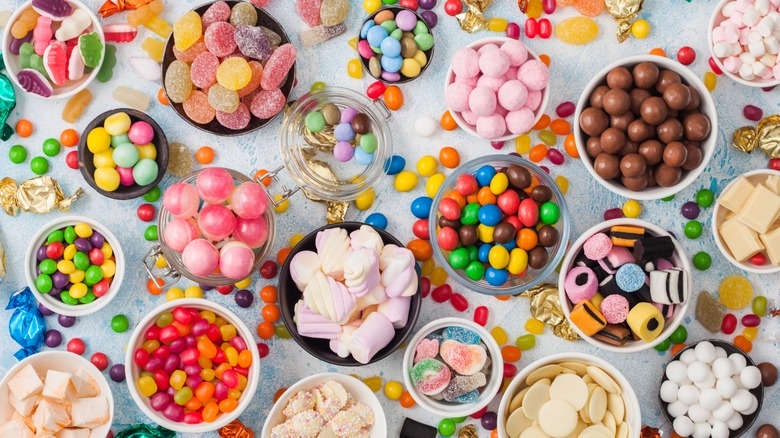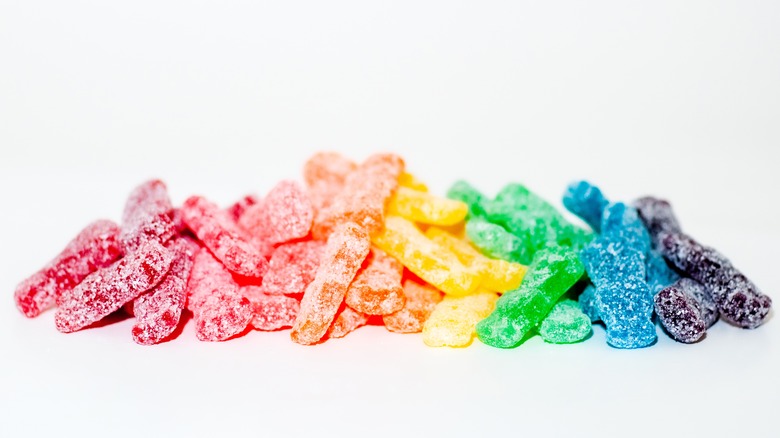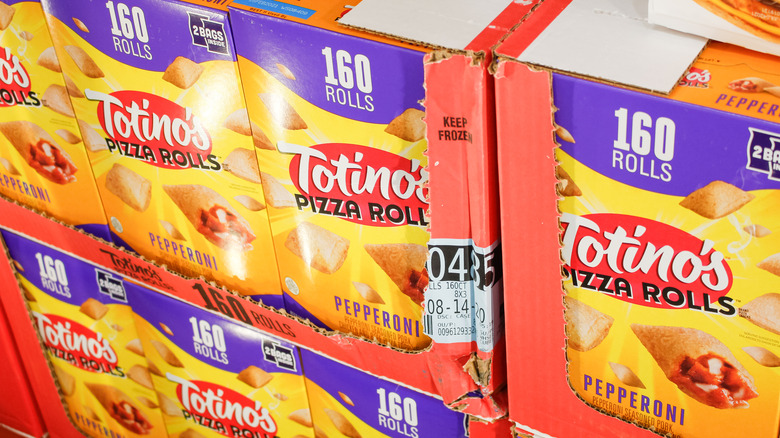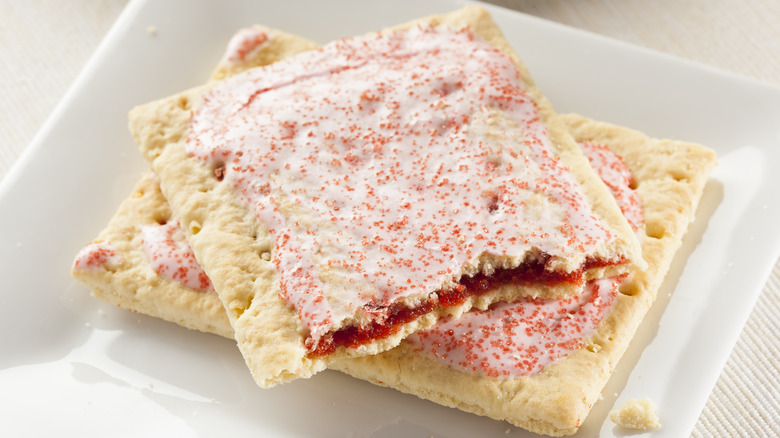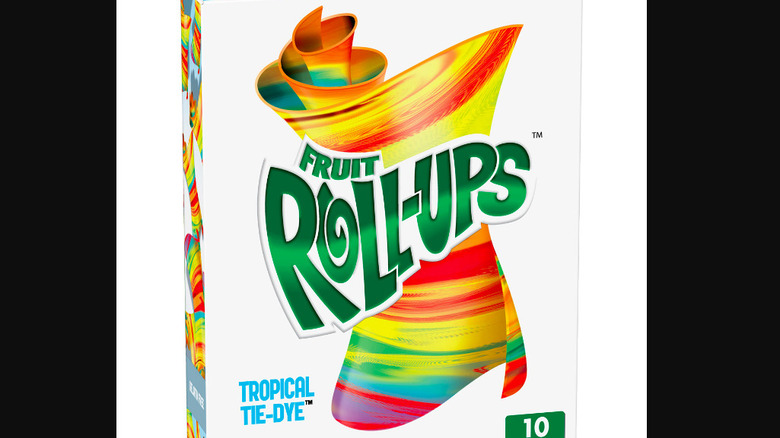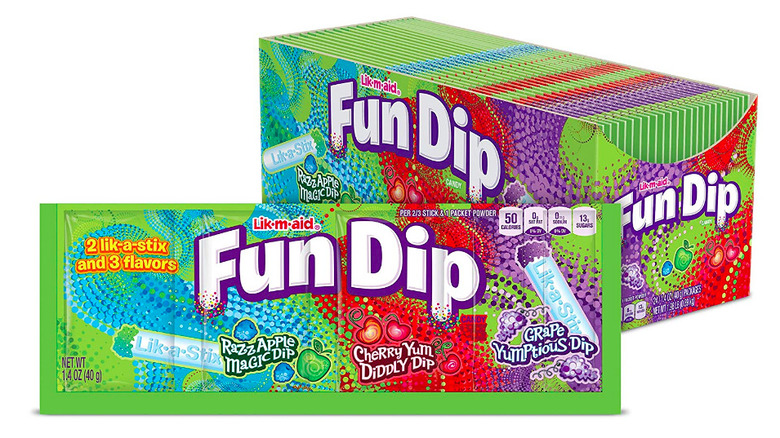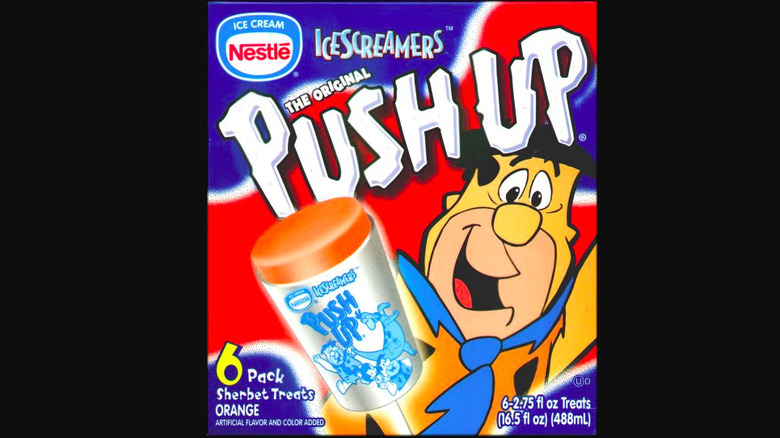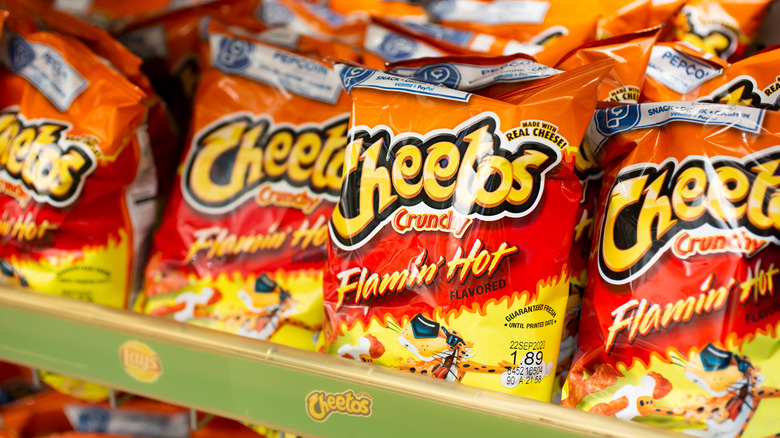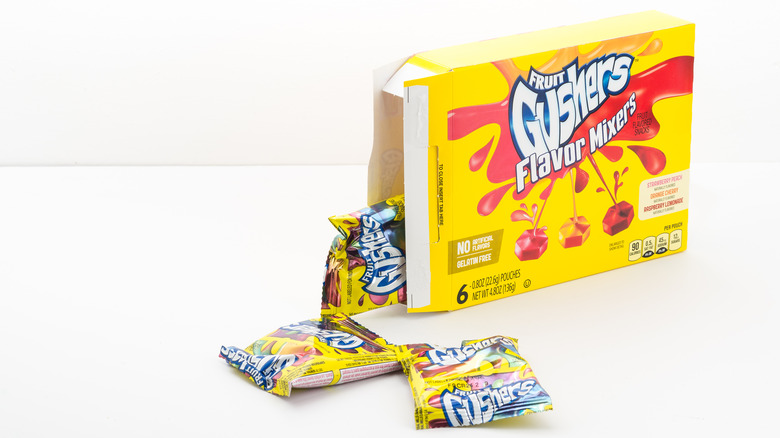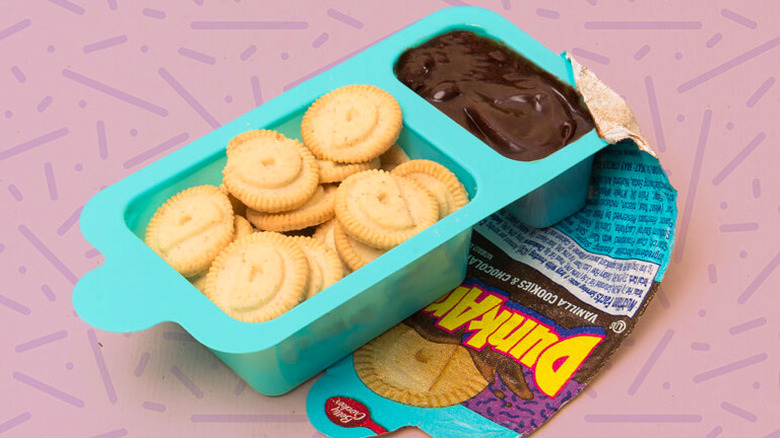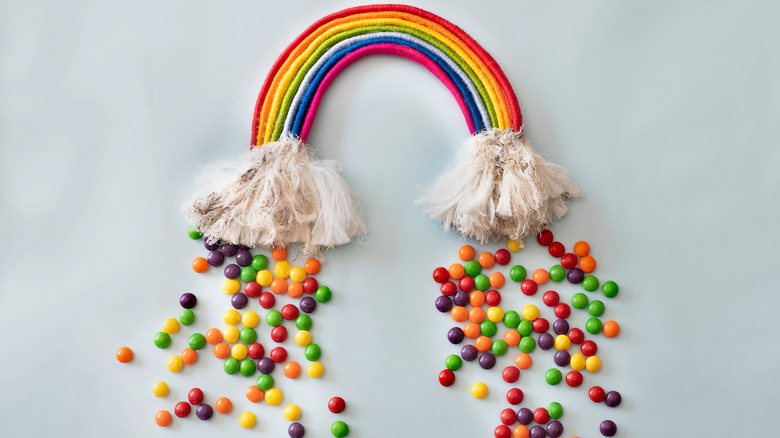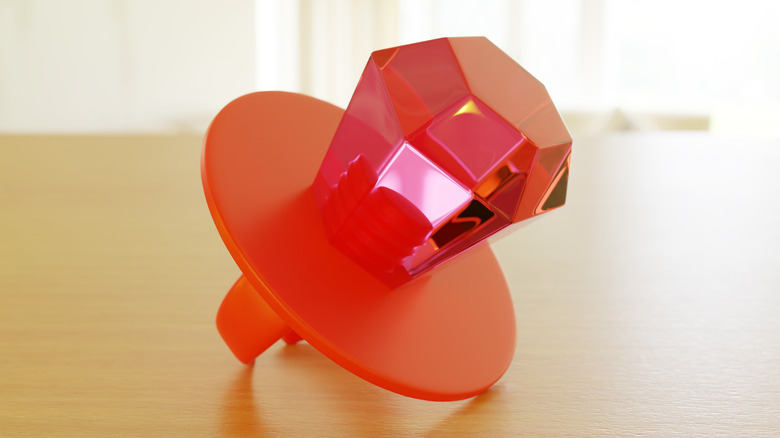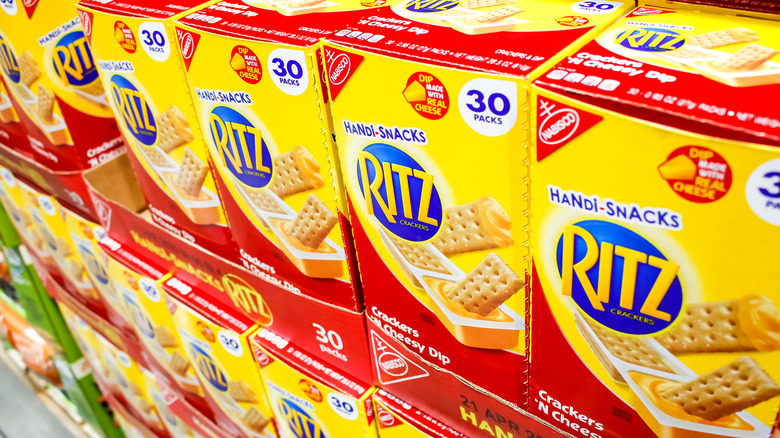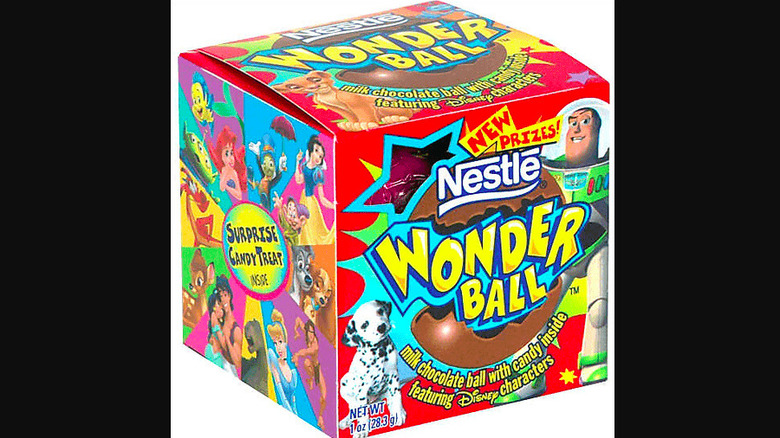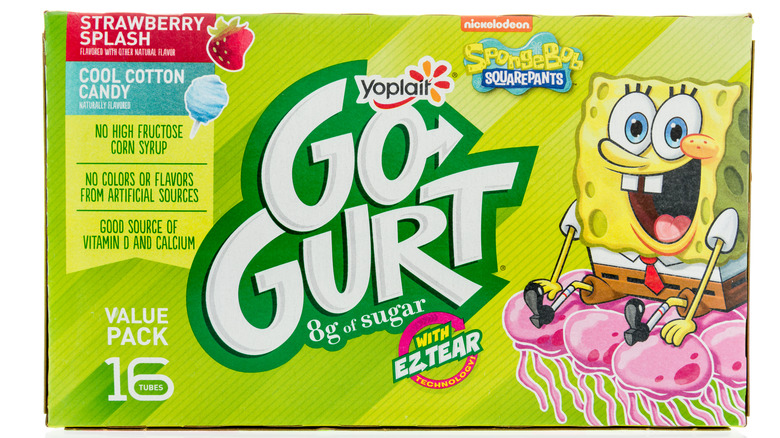What Junk Food Reigned Supreme The Year You Were Born?
To be a millennial: the '80s and '90s were that sweet spot of snack food history where snacking really took off, while concerns over healthy eating hadn't quite yet hit the mainstream consciousness. Since the 1950s, America has been well-known as a country that loves its snacks and junk food. Between 1980 and 1993, the number of new candy and snack products hitting grocery store shelves skyrocketed, and people couldn't get enough of these newfangled tasty and affordable treats (via National Museum of American History).
Junk foods are notoriously loaded with calories while lacking nutrients. Instead, they're full of processed sugar, salt, fat, and hard-to-pronounce ingredients. The snack scene started to shift in the early 2000s, when organic and health food products infiltrated the market as shoppers began to learn and understand how diet has an impact on health (per Food Dive). Still, however, Americans haven't slowed down on snacking — the U.S. snack market has continued to grow, making almost $116.6 billion in 2017 and hitting $150.6 billion in 2022, according to CNN Business. Let's take a walk down memory lane and revisit some of our favorite snacks of the past that are sure to stir up some nostalgia.
1985: Sour Patch Kids
If you've ever popped a Sour Patch Kid in your mouth, then you know: "First they're sour, then they're sweet." This was the Sour Patch Kids' popular slogan, pasted on their packaging and plugged into all their commercials (via Mashed). Now it's morphed into "Sour. Sweet. Gone." Sour Patch Kids first came out in 1985 and were almost immediately in demand, according to the Bulk Candy Store. The flavor combo of sweet and sour is evidently very addicting. Is your mouth salivating yet?
The product first started out with the name Mars Men and alien-shaped candy to match the space obsession of the 1970s, but they were quickly remolded to look like kids when the Cabbage Patch Kids became a sensation. And the rest is history. The original flavors were orange, cherry, lemon, and lime. The brand packaging has changed a lot over the years, and in 2013, blue raspberry officially joined the line-up. These days, the company has expanded its offerings to include Sour Patch Kids Extreme, BIG Sour Patch Kids, candy watermelons, cereal, and even ice cream. One thing is for sure, however, Sour Patch Kids still haven't gone out of style.
1986: Pizza rolls
Who doesn't love pizza? The only thing better than a pizza slice might be a bite-sized pizza roll. They're easy to make and easy to eat — probably the hardest thing about them is being able to wait long enough before devouring them to avoid burning the roof of your mouth. In fact, according to recent reports, 89% of Americans shared that they love, or at least like, pizza. "Pizza is America's favorite food," Mike Kostyo, a data analyst, told the Chicago Tribune.
In 1968, Jeno Paulucci created the pizza roll, inspired by his Italian roots and love for Chinese food. He wanted to combine a slice of pizza with an egg roll, and thus, the pizza roll was born (via The New York Times). He sold them through his company, Jeno's Inc., until Pillsbury bought them out in 1985. Pillsbury trademarked the name Totino's Pizza Rolls shortly after, and they have grown in popularity ever since. Today, Totino's Pizza Rolls are so well liked that they make up at least 26% of sales in the frozen snacks section of many stores across America, per The Michigan Daily. And they still taste just as good as you remember.
1987: Pop-Tarts
Even though Pop-Tarts were invented in 1964, they saw a massive sales increase beginning in the early 1980s, due to Kellogg's marketing aimed at multiple generations: kids, teens, and adults. When Pop-Tarts first debuted, their name was "Fruit Scone," which obviously didn't stick. Interestingly enough, the Pop-Tarts brand name "was influenced by Andy Warhol's Pop-Art in the 1960s," a Kellogg's spokesperson told the HuffPost.
The original Pop-Tarts were lacking frosting and the first flavors were Apple Currant Jelly, Strawberry, Blueberry, and Brown Sugar Cinnamon. Three years later, more flavors were released — this time with frosting — and kids were hooked. So much so that Kellogg's supposedly sells over 2 billion Pop-Tarts each year, per HuffPost. Who can say no to a warm, strawberry flavored Pop-Tart fresh from the toaster and covered in sprinkles? According to Kellogg's, Frosted Strawberry is the number one best seller, with Frosted Brown Sugar Cinnamon coming in a close second.
1988: Fruit Roll-Ups
At first, Fruit Roll-Ups may not sound like junk food. After all, the word "fruit" is in the name, and they do indeed contain fruit, however, the first two listed ingredients are corn syrup and sugar. They also have a touch of palm kernel oil, as well as red 40, yellows 5 and 6, and blue 1 (via Betty Crocker). General Mills, the maker of Fruit Roll-Ups, was actually sued in 2011 for false marketing campaigns leading the public to believe that Fruit Roll-Ups were a "healthy" food, when in reality, they are far from it, per Snack History.
Regardless, General Mills nailed a snack that was pleasing for both parents and kids. Adults could feel good that their children were eating at least some fruit and getting Vitamin C, while kids were actually allowed to play with their food. They could roll it up, mold it, tear it, make it into a ball, or even get some temporary tongue tattoos. The product was modeled after fruit leather, with the founding flavors, including strawberry, apple, apricot, and cherry. Gradually, they released more exciting options, like Tropical Tie-Dye and Electric Blue Raspberry. And despite the controversy, you can still find Fruit Roll-Ups in stores today.
1989: Fun Dip
Fun Dip was the ultimate candy sensation — sugar and playtime all in one. In reality, Fun Dip was nothing but sugar and unnatural ingredients. Basically a level-up on the classic Pixy Stix candy, Fun Dip is a colorful powdered sugar candy that you eat by licking then dipping a candy stick inside the package. One package of Fun Dip, with the Fun Dip white candy stick and tangy powder is equivalent to about three packets of sugar (via Food Network).
The first version of Fun Dip came out in 1973, with the name Lik-m-Aid, and included two tarty fruit-themed powders accompanied by one Lik-a-Stix. Shortly after, the name Fun Dip was added, and the package was updated to contain three different powders and two sticks, per Collecting Candy. The classic three flavors are Cherry Yum Diddly Dip, Razz Apple Magic, and Grape Yumptious Dip. Over the years, the flavors got even more creative, like blue raspberry that turned into green apple once it hit your tongue and a grape flavor guaranteed to dye your tongue purple.
1990: Flintstone's IceScreamers Push Ups
There's nothing quite like that serotonin rush when you hear the jingle of the ice cream truck in the distance. As a kid in the '90s, hearing that song meant that you immediately drop whatever you are doing, grab some change, and run outside. Of course, it was always a tough decision when it came to which ice cream to get, but one that really sticks out from the rest was Flintstone's Push Up pops. These sherbet treats were invented by Nestle and playfully called IceScreamers. They came in many delicious flavors, including Yabba Dabba Doo Orange, Bedrock Berry, Lime Rock Lime, Stone Age Strawberry, Granite Grape, Cave Kid Cherry, and Raspberry Rubble (per 80's Baby).
Even if you didn't love sherbet, Nestle made the Flintstone's pops fun and interactive. Your job was to race against the summer heat and push the ice cream out of a cardboard tube decorated with colorful Flintstone cartoon characters before it all melts. Push Up pops still exist, but the Flintstone's theme has long since been retired, though they will live on forever in our memories.
1991: Flamin' Hot Cheetos
Cheetos have always been a classic go-to snack, but it's hard to imagine the brand without Flamin' Hot Cheetos. These spicy, cheesy chips came out in 1991, and there has been some controversy over who actually invented them. For a while, Richard Montañez, a janitor at a Frito-Lays plant in California, claimed it was his idea. His romantic underdog story says that he envisioned a spicy Cheeto influenced by his Mexican-American roots, proposed this idea to the CEO, and it became an instant hit. The only problem is, shortly after his story came out, The Los Angeles Times did some digging and found that the facts didn't line up. Frito-Lay told the Times that the creation of Flamin' Hot Cheetos was actually a group effort, but Montañez was never in the brainstorming room.
Either way, the spicy snacks have captured the hearts — and taste buds — of many Americans. In fact, Flamin' Hot Cheetos still remain extremely popular. Sales data from goPuff, a snack delivery service, reports that Flamin' Hot Cheetos was their most commonly ordered snack, coming in first place in 2017, 2018, and 2019, per Ad Week. The runner up? Fruit Gushers Flavor Mixer.
1992: Fruit Gushers
Fruit Gushers: they're sweet, colorful, and chewy, with a surprise juicy center. This snack was created in the early '90s by the same company that made Fruit Roll-Ups — Betty Crocker and General Mills. Like Fruit Roll-Ups, don't be fooled with the word "fruit" in the name — this tasty treat lands more in the candy category (via Mashed). Gushers do have some fruit in them, and contain similar ingredients to Fruit Roll-Ups, like sugar, corn syrup, fruit puree concentrate, modified corn starch, fructose, maltodextrin, palm oil, and food coloring (via Betty Crocker). Surprisingly, Gushers are vegan and gluten-free. Instead of using gelatin to make them chewy like their gummy candy relatives, they contain agar-agar, a jelly-like material derived from seaweed.
And who can forget the particularly strange Gushers commercials in the '90s that featured children's heads transforming into disturbing images of fruit after eating a single Fruit Gusher (via YouTube). The ad contained slogans like, "So fruity, they'll really turn your head" and "A blast of fruit punch that's going to drive you totally fruity." You know what they say — you are what you eat.
1993: Dunkaroos
Dunkaroos were the epitome of junk food. This prepackaged snack came in a tiny plastic container housing cookies and icing to dip them in. One small package of Dunkaroos contains a massive 13 grams of sugar. It's enough to have any kid bouncing off the walls, just like the product's kangaroo mascot, Sydney. Dunkaroos were released in 1992 with five different cookie shapes and your choice of chocolate or vanilla frosting. But after new flavors came out in 1993 – chocolate chip, cinnamon, peanut butter, and rainbow sprinkles — they really blasted off (via Newsweek).
The cookies were all the rage in the 1990s and into the early 2000s, but they eventually lost steam towards the end of the decade, per Mashed. Then in 2012, Dunkaroos were discontinued in America, much to everyone's dismay. However, they have just made a comeback — and adults (and children) across America rejoiced. In 2020, Dunkaroos announced they would be returning, but only with the chocolate and vanilla frosting with rainbow sprinkles flavors back in stock for now. They also released a few new products, including Dunkaroos cereal, Dunkaroos with yogurt, sugar cookie mix, pancake mix, and the beloved vanilla icing and rainbow sprinkles in a tub. To find Dunkaroos products near you, check out their website, which still looks like it belongs in yesteryear.
1994: Skittles
Say it with me: "Taste the rainbow." Even though Skittles hit U.S. store shelves in 1979 and steadily gained popularity in the '80s, the "Taste the Rainbow" ad campaign in 1994 was a game changer. As a matter of fact, the phrase has become one of the longest-running slogans out there (via Mashed) with over 40 "Taste the Rainbow" commercials being aired so far, per The Drum. Some are funny, some are dark, and some are just downright creepy — like the one featuring a full grown adult man guessing the flavor of each Skittle his mom is eating by using the umbilical cord that is still attached to both of them. That ad came out for Mother's Day in 2017 (via YouTube).
When Skittles were first created, the original flavors were grape, orange, strawberry, lemon, and lime. Since then, they've released many more. Some took off, while others crashed and burned. Skittles Sour and Skittles Tropical Fruit did very well, but other ideas like Fizzl'd Fruits, which was modeled after the popular Pop Rocks, were only on shelves for two years (via Mashed). In any case, Skittles still remain a huge pillar of the candy aisle.
1995: Ring Pops
If you never pretended like a Ring Pop was your engagement ring, were you even a kid in the '90s? Fun fact: Ring Pops were actually created in the late '70s by a father named Frank Richards who was trying to come up with a fun way for his daughter to stop sucking her thumb. Wearing a lollipop on your finger is a much more exciting solution to thumb sucking than putting socks on your hands. For this reason, the Ring Pop design was actually modeled after a pacifier (via Snack History).
The popularity of Ring Pops grew throughout the '80s and well into the '90s. There were only two starting flavors, cherry and grape, but over the years, five more flavors have been added to the lineup, including blue raspberry, strawberry, watermelon, lime, and green apple. There is also an entire Sour Ring Pop line, Twisted flavors, and Ring Pop gummies. Ring Pops have stood the test of time and are still available for purchase in many stores across the U.S.
1996: Handi-snacks cheese and crackers
Cheese and crackers is a classic snack that was made quintessential by Nabisco and the little red stick packed inside. Nabisco, which later became Kraft, took note of the wild success of Dunkaroos and capitalized on it by creating a savory version. The little packages contain two compartments, one for crackers and one for "cheese," plus a little red stick for cheese spreading. The reason these goodies made it on the junk food list is because they do not contain real cheese. Instead, the cheesy sauce was made with whey protein concentrate, canola oil, maltodextrin, and a touch of cheddar cheese (via Food Network).
Kraft went on to release other Handi-Snacks products, like breadsticks and cheese, eliminating the need for the iconic tiny red stick. Other items that were not as successful included pretzels and cheese, a peanut butter and cracker version, and an Oreo cookie stick and cream dip (via Children of the Nineties). Sorry, but the Oreo Sticks 'n Creme had nothing on Dunkaroos. Still, Handi-Snacks were an instant crowd favorite, and in 1996 alone, they raked in $79 million of profit, per Snack Stack.
1997: Nestle's wonder ball
The Wonder Ball might have had one of the catchiest jingles out there: "Oh, I wonder, wonder what's in a Wonder Ball?" (via YouTube) Is it still stuck in your head? A Wonder Ball has everything a kid dreams of — toys and the element of surprise wrapped in a deliciously sweet ball of milk chocolate. Created by Nestle, Wonder Balls first started off as a hollow ball of chocolate that housed a tiny children's toy, usually a Pokémon or Disney character, and they were actually called Magic Balls (via Buzz Feed). In 1997, the product was recalled, because unhappy parents thought the toys were choking hazards (via Bustle).
Wonder Balls were re-released to the public in 2000, this time with surprises of edible candy inside instead of toys. This version was sold until 2004, when they mysteriously disappeared off shelves. To many millennials' delight, Wonder Balls are back, this time featuring new characters from Disney, Super Mario Bros., Monsters Plus, and Despicable Me. Not only do they have candy, but they also come with stickers and some even have — gasp — toys.
1998: GoGurt
GoGurt made this list for two reasons. First of all, it was so iconic in the '90s that any snack round-up would be incomplete without it. And secondly, as hard as Yoplait tried to market GoGurt as a healthy snack, it's still in the junk food category. Why? Even though GoGurt is low in fat and the modern product is now free of high fructose corn syrup and artificial colors, it is still loaded with lots of sugar (via Yoplait). Three tubes of GoGurt contain a whopping 23 grams of sugar — that's 36% of the recommended daily value. And we all know kids can't eat just one.
Regardless of this fact, GoGurt was still high in demand as soon as they made it to market in 1998 (via Mashed). In fact, TIME said GoGurt was "the fastest-selling yogurt product ever released," according to General Mills. GoGurt was super convenient — no spoon or clean up required. As their commercials pointed out, GoGurt is "the yogurt you squeeze and slurp, grab and glurp." The product seems to keep pumping out new themes and flavors that are irresistible to kids, like the Glo-Gurt that comes with glow in the dark Halloween decorated tubes, and creative flavors like Cotton Candy and the infamous Sour Patch variety that's based on — you guessed it — the Sour Patch Kids.
